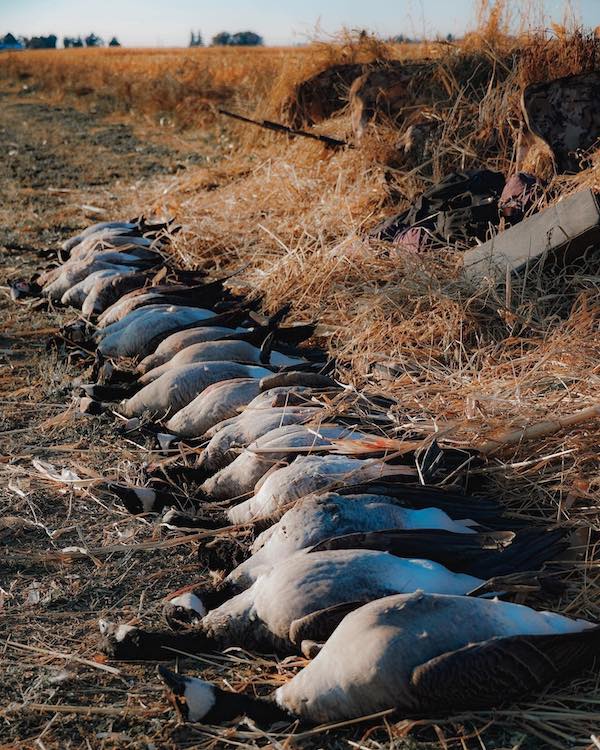
Late-season Waterfowl: Easy On Calling, Work On Concealment
By Rachel Voss
The 2022/23 waterfowl season in Washington started out strong with birds, birds, and more birds. The early season brought mild temps and some very impressive numbers of ducks and geese being harvested throughout the state. As we all know, the avian bird flu was a hot topic in different parts of Washington, but we really didn’t see it affect harvest numbers, as hunting stayed fairly consistent in most counties.

Don’t get me wrong; I’m not saying that the early-season birds were “pushovers,” but they were around!! As long as you worked some tried-and-true tactics (the right spread, calling, and hide), having feet down in the decoys didn’t seem to pose a problem for most.
Duck and goose hunting is a solid weather game, and this season Mother Nature threw us all a few curveballs in the Pacific Northwest. In midseason we saw extreme temps and freezing digits that were enough to make even the most waterfowl-obsessed people question their sanity. Heck, we all want that perfect windy, cold, bluebird day, when the birds just come dumping into your setup. Instead, we had negative degrees, everything freezing up and some confused birds.
As we head full steam into the latter part of the season, new birds are beginning to cycle in, setting the stage for what could be an epic last few weeks. Although we may have limited time in the season, if you can get out in the blind or on the water, the birds should still be abundant. It can be easy for both new and seasoned waterfowlers to get discouraged with these wary late-season birds, but they are VERY huntable. If I could give you two simple tips to throw into your blind bag as we roll into the end of the season, they would be: keep your calling simple and your hide complete.

By simple calling, I really do mean simple. You don’t necessarily want to be completely silent, but often just a simple “quack” for wary ducks will seal the deal. Anything too fast and rapid-fire sounding can often just alarm them this time of year. If you have a large group working, pick out that one bird – the one that clearly wants in, that suicide duck – and then key into what gets it fired up and looking. It’s all about adapting to the birds at this point in the season.
For those late-season, frosty honkers, stick to low-toned soft clucks and moans. It’s not uncommon for breeding pairs to get split up and shuffle around with hunting pressure. A long, drawn-out lonesome honk will almost always pull these lonely fliers in. I like to turn to my Pacific Calls PCG to achieve that deep beautiful tone. (Northwest Sportsman readers can use a one-time code for 25% off: NWSVOSS25)
Last, and certainly NOT least, for the love of all things wings, make sure you’re concealed!! Without a good hide for these late-season, know-it-all birds, you will be watching birds flare and waving goodbye to the southbound end of ducks and geese! If you have birds that are consistently not finishing in the late season, it’s usually as simple as they’re seeing you.
Make sure to freshen up those blinds with brush and vegetation consistently throughout the year. If you’re hunting from layout blinds, watch your shadows. If you had birds working early in the morning but see them starting to not finish later in the morning, jump out and do a once-over on your hide. You would be shocked at how large of a shadow it will throw as the sun continues to rise. This is a huge issue and will flare birds nearly every time.
- WASHINGTON WATERFOWL DATES
- Statewide general duck, coot and snipe seasons run through January 29
- Statewide youth, veterans and active military waterfowl day: February 4 (except no brant goose hunt in Skagit County, snipe closed)
- See regs for goose management areas regular and late-season dates
The fix is as simple as turning and/or moving your blind to avoid that shadow. Along the same line is making sure you switch it up with the layout. These “eagle eyes” are pretty darn smart at this point in the season; it’s nothing for them to remember exactly where your blind(s) are set. As birds began to familiarize themselves with the same setups they see over and over, it’s important to switch things up on the ground.
As we round the corner to the tail end of the season, the migration is flowing and things are looking sharp with incoming numbers. I hope you all can capitalize on every last opportunity you get and you find yourselves setting your decoys a few more times before season’s end. Here’s to full straps, piles and smiles for all.
Editor’s note: When she’s not duck or goose hunting, author Rachel Voss works on wildlife conservation and legislation, hunter advocacy, and getting more women into hunting in Washington.


